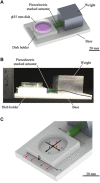Collective cell migration of fibroblasts is affected by horizontal vibration of the cell culture dish
- PMID: 32944015
- PMCID: PMC7481772
- DOI: 10.1002/elsc.202000013
Collective cell migration of fibroblasts is affected by horizontal vibration of the cell culture dish
Abstract
Regulating the collective migration of cells is an important issue in bioengineering. Enhancing or suppressing cell migration and controlling the migration direction is useful for various physiological phenomena such as wound healing. Several methods of migration regulation based on different mechanical stimuli have been reported. While vibrational stimuli, such as sound waves, show promise for regulating migration, the effect of the vibration direction on collective cell migration has not been studied in depth. Therefore, we fabricated a vibrating system that can apply horizontal vibration to a cell culture dish. Here, we evaluated the effect of the vibration direction on the collective migration of fibroblasts in a wound model comprising two culture areas separated by a gap. Results showed that the vibration direction affects the cell migration distance: vibration orthogonal to the gap enhances the collective cell migration distance while vibration parallel to the gap suppresses it. Results also showed that conditions leading to enhanced migration distance were also associated with elevated glucose consumption. Furthermore, under conditions promoting cell migration, the cell nuclei become elongated and oriented orthogonal to the gap. In contrast, under conditions that reduce the migration distance, cell nuclei were oriented to the direction parallel to the gap.
Keywords: cell migration; fibroblast; mechanotransduction; vibrational stimulation; wound healing.
© 2020 The Authors. Engineering in Life Sciences published by WILEY‐VCH Verlag GmbH & Co. KGaA, Weinheim.
Conflict of interest statement
The authors have declared no conflict of interest.
Figures






References
-
- Friedl, P. , Gilmour., D. , Collective cell migration in morphogenesis, regeneration and cancer. Nat. Rev. Mol. Cell Biol. 2009, 10, 445–57. - PubMed
-
- Lauffenburger, D. A. , Horwitz., A. F. , Cell migration, A physically integrated molecular process. Cell 1996, 84, 359–369. - PubMed
-
- Weijer, C. J. , Collective cell migration in development. J. Cell Sci. 2009, 122, 3215–3223. - PubMed
-
- Masui, T. , Doi, R. , Mori, T. , Toyoda, E. , et al., Metastin and its variant forms suppress migration of pancreatic cancer cells. Biochem. Biophys. Res. Commun. 2004, 315, 85–92. - PubMed
LinkOut - more resources
Full Text Sources
Research Materials
Miscellaneous
